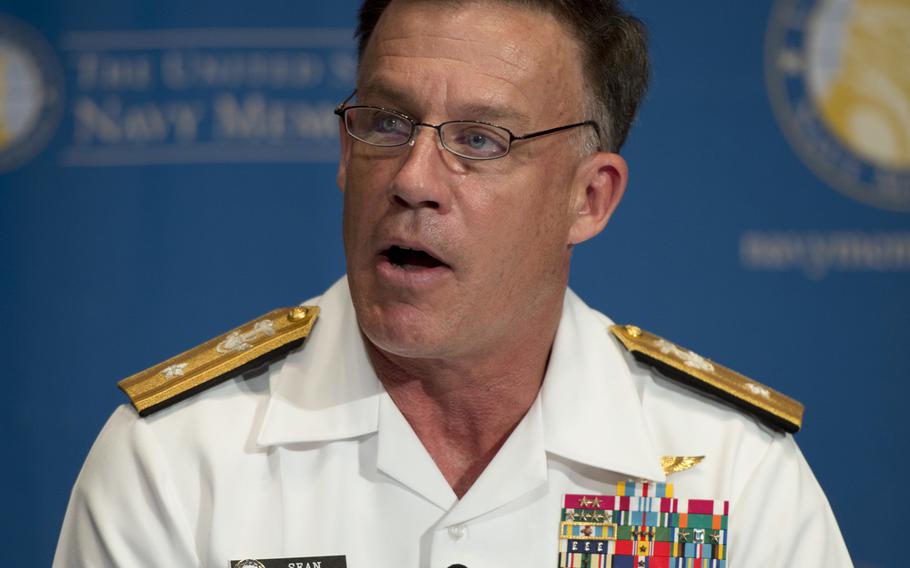Migration
Sexual assault prevention, response training: What works best?
Stars and Stripes January 24, 2014

Rear Adm. Sean Buck, the Director of the 21st Century Sailor Office, responds to questions at a sexual assault prevention panel held at the United States Navy Memorial, Washington July 31, 2013. (Christofer Baines/USMC file photo)
SAN DIEGO – As the head of the Navy’s 21st Century Sailor Office talks to sailors about what sexual assault prevention and response training works and what doesn’t, a clear theme has emerged: No one likes PowerPoint presentations.
Sailors are very positive about small group training, actors demonstrating different scenarios and how to respond, new videos targeted to specific environments in the Navy and other types of training, said Rear Adm. Sean Buck. But computer-based training and PowerPoint productions are not high on anyone’s list.
Buck says he has had “phenomenal response” when he asks sailors about sexual assault prevention training. “Nobody’s shy about this topic,” he said. “It was very heartening to me to see how well informed they were about sexual assault and preventing it, as well as how passionate they are to get this problem out of our Navy.”
Buck last week kicked off a six-month, round-the-world tour of Navy bases in San Diego, where he met with hundreds of sailors and talked about the wide variety of programs his office covers.
The 21st Century Sailor Office covers a range of readiness and resiliency programs that encompass “the total fitness of the sailor,” Buck said: sexual assault prevention and response, suicide prevention, alcohol and substance abuse prevention, sexual harassment prevention, hazing and bullying prevention, physical fitness and family programs.
Buck believes the best ideas about those issues will come from the fleet.
“Sailors will take this into their own hands and solve it themselves,” he told Stars and Stripes. “I’m the guy who can resource their efforts.”
Many sailors are working to combat many of the problems Buck’s office addresses. Young sailors around the world have voluntarily started more than 300 chapters of a group called the Coalition of Sailors Against Destructive Decisions – a group that works to educate other sailors about safe decision-making and fun activities they can participate in during time off that do not include alcohol, Buck said.
The groups have similar goals to the Navy’s more official bystander intervention training, which teaches sailors when and how to step in to prevent their friends and shipmates from getting into bad or potentially dangerous situations.
Buck believes the numbers show that some of the training is working. The fiscal 2013 numbers will not be released until spring, but Buck said unrestricted reports of sexual assault were up 46 percent over fiscal 2012. There were 527 unrestricted reports of sexual assault in the Navy in fiscal 2012, a 29 percent increase from the previous year.
“We anticipated a large number of reports, an increase in reporting,” Buck said, as sailors gain more confidence in the system and victims are no longer afraid they will be retaliated against for reporting a crime.
“That’s the anecdotal feedback that we’re getting from scores and scores of sailors, that they have a huge trust in their leadership, that they’re now part of a … team that will take their reports seriously,” he said, adding that the trust “was not necessarily the feelings of the past.”
Still, there are obstacles.
The annual report of sexual assaults at the military academies showed a high percentage of restricted reports -– reports that allow the victim to seek medical help or therapy but not pursue legal action against the offender. Victims who file a restricted report can later choose to make the report unrestricted.
At the Naval Academy, 11 of the 15 reported sexual assaults remained restricted at the end of the year.
Buck said it illustrates the issue of peer pressure at the service academies.
“We still have work to do in that regard to help the midshipmen,” he said, and much of it comes down to bystander intervention and taking care of one another.
“One of the hardest things that you can do is hold a peer accountable, to step in and intervene, try to keep a peer, friend, shipmate or family member from making a destructive decision,” he said. “The more that we can encourage and train and help our sailors become bystanders, the quicker we will solve these problems.”
hlad.jennifer@stripes.com Twitter: @jhlad